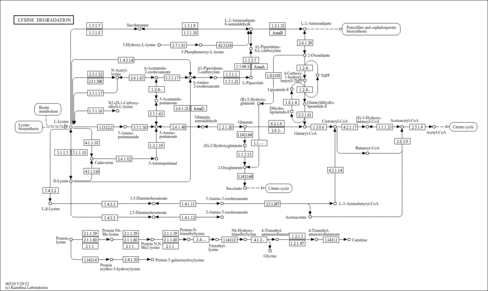| GC-MS Spectra| Spectrum Type | Description | Splash Key | Deposition Date | Source | View |
|---|
| Predicted GC-MS | Predicted GC-MS Spectrum - 2,3,4,5-Tetrahydro-2-pyridinecarboxylic acid GC-MS (Non-derivatized) - 70eV, Positive | splash10-0f9x-9000000000-7bc5d56fa658fac7e9e0 | 2017-09-20 | Wishart Lab | View Spectrum | | Predicted GC-MS | Predicted GC-MS Spectrum - 2,3,4,5-Tetrahydro-2-pyridinecarboxylic acid GC-MS (1 TMS) - 70eV, Positive | splash10-001i-9100000000-26047328d0a1182e46ed | 2017-10-06 | Wishart Lab | View Spectrum | | Predicted GC-MS | Predicted GC-MS Spectrum - 2,3,4,5-Tetrahydro-2-pyridinecarboxylic acid GC-MS (Non-derivatized) - 70eV, Positive | Not Available | 2021-10-12 | Wishart Lab | View Spectrum |
MS/MS Spectra| Spectrum Type | Description | Splash Key | Deposition Date | Source | View |
|---|
| Predicted LC-MS/MS | Predicted LC-MS/MS Spectrum - 2,3,4,5-Tetrahydro-2-pyridinecarboxylic acid 10V, Positive-QTOF | splash10-01t9-3900000000-7acf87e49673fc08eeaa | 2017-10-06 | Wishart Lab | View Spectrum | | Predicted LC-MS/MS | Predicted LC-MS/MS Spectrum - 2,3,4,5-Tetrahydro-2-pyridinecarboxylic acid 20V, Positive-QTOF | splash10-001i-9400000000-6ae0da8e10e93ebebb84 | 2017-10-06 | Wishart Lab | View Spectrum | | Predicted LC-MS/MS | Predicted LC-MS/MS Spectrum - 2,3,4,5-Tetrahydro-2-pyridinecarboxylic acid 40V, Positive-QTOF | splash10-0f8c-9000000000-a147c4de8fc31bccca5d | 2017-10-06 | Wishart Lab | View Spectrum | | Predicted LC-MS/MS | Predicted LC-MS/MS Spectrum - 2,3,4,5-Tetrahydro-2-pyridinecarboxylic acid 10V, Negative-QTOF | splash10-004i-2900000000-f6e66950933f111873a1 | 2017-10-06 | Wishart Lab | View Spectrum | | Predicted LC-MS/MS | Predicted LC-MS/MS Spectrum - 2,3,4,5-Tetrahydro-2-pyridinecarboxylic acid 20V, Negative-QTOF | splash10-003r-7900000000-c03c466dc61aeb1bfe71 | 2017-10-06 | Wishart Lab | View Spectrum | | Predicted LC-MS/MS | Predicted LC-MS/MS Spectrum - 2,3,4,5-Tetrahydro-2-pyridinecarboxylic acid 40V, Negative-QTOF | splash10-001i-9000000000-45b9069abf74b9d12e30 | 2017-10-06 | Wishart Lab | View Spectrum | | Predicted LC-MS/MS | Predicted LC-MS/MS Spectrum - 2,3,4,5-Tetrahydro-2-pyridinecarboxylic acid 10V, Positive-QTOF | splash10-001i-9200000000-cbf1b8e349aa6ca99662 | 2021-09-22 | Wishart Lab | View Spectrum | | Predicted LC-MS/MS | Predicted LC-MS/MS Spectrum - 2,3,4,5-Tetrahydro-2-pyridinecarboxylic acid 20V, Positive-QTOF | splash10-001i-9000000000-29fae23b5d3c449f94d6 | 2021-09-22 | Wishart Lab | View Spectrum | | Predicted LC-MS/MS | Predicted LC-MS/MS Spectrum - 2,3,4,5-Tetrahydro-2-pyridinecarboxylic acid 40V, Positive-QTOF | splash10-001i-9000000000-56e545e596bbc86defd6 | 2021-09-22 | Wishart Lab | View Spectrum | | Predicted LC-MS/MS | Predicted LC-MS/MS Spectrum - 2,3,4,5-Tetrahydro-2-pyridinecarboxylic acid 10V, Negative-QTOF | splash10-004i-0900000000-f5ad3a146c0d7eb97e47 | 2021-09-25 | Wishart Lab | View Spectrum | | Predicted LC-MS/MS | Predicted LC-MS/MS Spectrum - 2,3,4,5-Tetrahydro-2-pyridinecarboxylic acid 20V, Negative-QTOF | splash10-0059-4900000000-bd8c2d97a8df0a7c74c9 | 2021-09-25 | Wishart Lab | View Spectrum | | Predicted LC-MS/MS | Predicted LC-MS/MS Spectrum - 2,3,4,5-Tetrahydro-2-pyridinecarboxylic acid 40V, Negative-QTOF | splash10-000x-9000000000-4ee1f563852d8b5ca9f3 | 2021-09-25 | Wishart Lab | View Spectrum |
NMR Spectra| Spectrum Type | Description | Deposition Date | Source | View |
|---|
| Predicted 1D NMR | 13C NMR Spectrum (1D, 100 MHz, D2O, predicted) | 2021-09-25 | Wishart Lab | View Spectrum | | Predicted 1D NMR | 1H NMR Spectrum (1D, 100 MHz, D2O, predicted) | 2021-09-25 | Wishart Lab | View Spectrum | | Predicted 1D NMR | 13C NMR Spectrum (1D, 1000 MHz, D2O, predicted) | 2021-09-25 | Wishart Lab | View Spectrum | | Predicted 1D NMR | 1H NMR Spectrum (1D, 1000 MHz, D2O, predicted) | 2021-09-25 | Wishart Lab | View Spectrum | | Predicted 1D NMR | 13C NMR Spectrum (1D, 200 MHz, D2O, predicted) | 2021-09-25 | Wishart Lab | View Spectrum | | Predicted 1D NMR | 1H NMR Spectrum (1D, 200 MHz, D2O, predicted) | 2021-09-25 | Wishart Lab | View Spectrum | | Predicted 1D NMR | 13C NMR Spectrum (1D, 300 MHz, D2O, predicted) | 2021-09-25 | Wishart Lab | View Spectrum | | Predicted 1D NMR | 1H NMR Spectrum (1D, 300 MHz, D2O, predicted) | 2021-09-25 | Wishart Lab | View Spectrum | | Predicted 1D NMR | 13C NMR Spectrum (1D, 400 MHz, D2O, predicted) | 2021-09-25 | Wishart Lab | View Spectrum | | Predicted 1D NMR | 1H NMR Spectrum (1D, 400 MHz, D2O, predicted) | 2021-09-25 | Wishart Lab | View Spectrum | | Predicted 1D NMR | 13C NMR Spectrum (1D, 500 MHz, D2O, predicted) | 2021-09-25 | Wishart Lab | View Spectrum | | Predicted 1D NMR | 1H NMR Spectrum (1D, 500 MHz, D2O, predicted) | 2021-09-25 | Wishart Lab | View Spectrum | | Predicted 1D NMR | 13C NMR Spectrum (1D, 600 MHz, D2O, predicted) | 2021-09-25 | Wishart Lab | View Spectrum | | Predicted 1D NMR | 1H NMR Spectrum (1D, 600 MHz, D2O, predicted) | 2021-09-25 | Wishart Lab | View Spectrum | | Predicted 1D NMR | 13C NMR Spectrum (1D, 700 MHz, D2O, predicted) | 2021-09-25 | Wishart Lab | View Spectrum | | Predicted 1D NMR | 1H NMR Spectrum (1D, 700 MHz, D2O, predicted) | 2021-09-25 | Wishart Lab | View Spectrum | | Predicted 1D NMR | 13C NMR Spectrum (1D, 800 MHz, D2O, predicted) | 2021-09-25 | Wishart Lab | View Spectrum | | Predicted 1D NMR | 1H NMR Spectrum (1D, 800 MHz, D2O, predicted) | 2021-09-25 | Wishart Lab | View Spectrum | | Predicted 1D NMR | 13C NMR Spectrum (1D, 900 MHz, D2O, predicted) | 2021-09-25 | Wishart Lab | View Spectrum | | Predicted 1D NMR | 1H NMR Spectrum (1D, 900 MHz, D2O, predicted) | 2021-09-25 | Wishart Lab | View Spectrum |
IR Spectra| Spectrum Type | Description | Deposition Date | Source | View |
|---|
| Predicted IR Spectrum | IR Ion Spectrum (Predicted IRIS Spectrum, Adduct: [M-H]-) | 2023-02-03 | FELIX lab | View Spectrum | | Predicted IR Spectrum | IR Ion Spectrum (Predicted IRIS Spectrum, Adduct: [M+H]+) | 2023-02-03 | FELIX lab | View Spectrum | | Predicted IR Spectrum | IR Ion Spectrum (Predicted IRIS Spectrum, Adduct: [M+Na]+) | 2023-02-03 | FELIX lab | View Spectrum |
| Show more...
|---|
